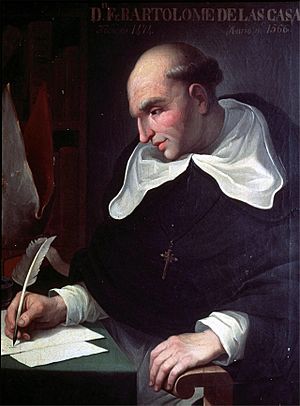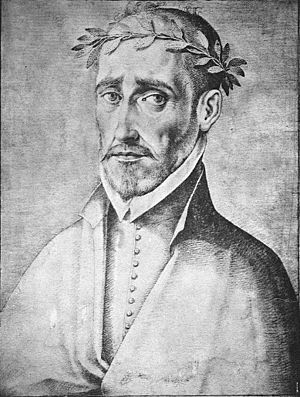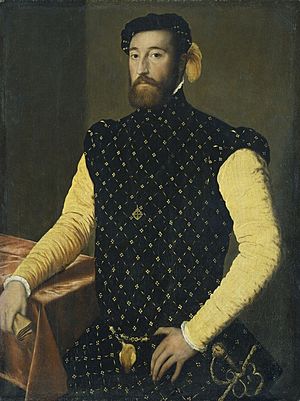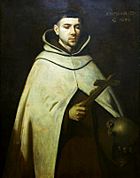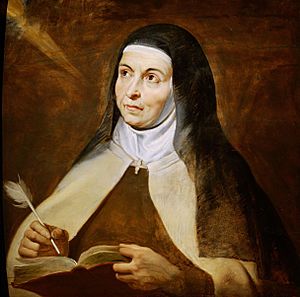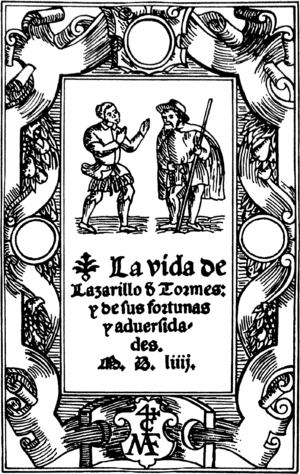Spanish Renaissance literature facts for kids
The Spanish Renaissance literature is all the amazing writing that came out of Spain during the Spanish Renaissance. This was a special time in history, mostly in the 15th and 16th centuries.
Spain was changing a lot, and so was its literature!
Contents
What Was the Spanish Renaissance in Literature?
Spain and Italy had strong connections in many ways, like politics, religion, and even their armies. These connections led to a huge exchange of ideas and culture between the two countries.
For example, two popes from Valencia (a region in Spain), Calixto III and Alejandro VI, helped bring Spain and Rome closer. This made it easier for new ideas to travel.
Printing presses started appearing in Spain around 1480. Many important Spanish books were first printed or translated in Italy, which was a big center for printing back then. Books like Amadís de Gaula and The Celestina became popular. The same happened with Italian books coming to Spain, like Jerusalén liberada. This exchange of ideas really kickstarted the Spanish Renaissance.
The Spanish Renaissance began when the Catholic Monarchs united Spain. It continued through the reigns of King Charles I and King Philip II. We can see two main parts to this period:
- King Charles I's time: New ideas arrived, and Spanish writers started to copy the style of the Italian Renaissance.
- King Philip II's time: The Spanish Renaissance became more focused on Spanish traditions and religious topics.
The way people thought during the Renaissance was also very unique:
- People really admired the ancient Greek and Roman worlds. They looked for new ways to value individuals, focusing less on just heaven.
- Humans became the most important part of the universe. People believed they could control their own lives and futures.
- Thinking and logic were more important than feelings. Balance, calmness, and harmony were highly valued.
- The ideal man was a "courtier" – someone who was good at both writing poetry and being a soldier.
- There was a new idea of beauty. People started to idealize the world around them (nature, women, love) not just as it was, but as it could be perfect.
Important Moments in the Spanish Renaissance
Many people say the Renaissance in Spain began in 1492. But it's actually more complicated because so many things happened around that time.
Spain's situation was always complex. Even so, the new ideas of humanism managed to grow. Humanism focused on human values and achievements.
One important event was the Reconquista in 1492, when the last Muslim rulers were expelled from Spain. This period was full of energy and new beginnings. The Spanish Inquisition also became a powerful group that worked closely with the Spanish government, not just the Church.
Important scholars appeared during the time of the Catholic Monarchs. One of the first major authors was Antonio de Nebrija (1442–1522). In 1492, he published the first grammar book for the Spanish language, called Gramática Castellana. This was a big deal because it helped make Castilian the official language of Spain, replacing Latin.
A great supporter of learning during the Renaissance was Cardinal Gonzalo Jiménez de Cisneros. He came from a humble background but was very strict. He worked hard to reform the religious groups and believed that education was key to this reform. In 1498, he founded the University of Alcalá de Henares. This university became very famous, almost as much as the University of Salamanca.
His ideas for reform were similar to those of Erasmus, whose teachings were very popular in Europe and Spain at the time.
During this period, writers like Pedro Mexía collected all sorts of scientific information. This showed the Renaissance idea that wisdom could be found everywhere, even among common people who were thought to be closer to nature.
The ideas of idealism and humanism also led to big discussions about Spain's activities in the New World (the Americas). A key figure in these debates was the Dominican friar Bartolomé de las Casas (1474–1566). He believed that war was wrong and that force should not be used against native people. He argued that religion should only be taught through kind and gentle persuasion.
Another important thinker was Francisco de Vitoria (1483–1546), a Dominican theologian and professor. He focused on real-world problems in politics and society. He was one of the first to set up the basic ideas of modern international law, based on natural rules. He supported basic freedoms like freedom of speech, communication, and trade. However, he believed that less developed groups needed to be governed by more advanced ones.
With the start of the Counter-Reformation, the spirit of tolerance in Spain faded. There was no agreement between Protestants and Catholics, and religious unity became very important. This marked the end of the Renaissance's open-mindedness. However, Spanish religious feeling found new ways to express itself through the Company of Jesus, founded by Saint Ignatius of Loyola (1491–1556). New ideas like Neoplatonism also arrived from Italy.
Renaissance Poetry
Poetry during this time was mainly divided into two styles: the Salmantine school and the Sevillian school.
The Salmantine School (like the poet Fray Luis de León) had these features:
- Clear and simple language.
- Ideas expressed in a straightforward way.
- Realistic topics.
- Preferred shorter verses.
The Sevillian School (like Fernando de Herrera) was different:
- More grand and elaborate.
- Very refined and polished.
- Focused more on deep thought than on feelings.
- Used long, complex verses.
- Full of descriptive words and fancy language.
This Sevillian style helped lead to the Baroque poetry of the 17th century.
Renaissance poetry came from two main sources:
- Old Traditions: This included medieval poetry, like popular songs and ballads. It also included more formal poetry from authors like Juan de Mena. This traditional poetry often used shorter, eight-syllable verses.
- New Italian Style: This was inspired by the Italian poet Petrarch. Poets like Juan Boscán and Garcilaso helped this style grow in Spain. It used longer, eleven-syllable verses and new poem forms.
Key features of Renaissance poetry:
- New Forms: Poets adopted Italian forms like eleven-syllable verses, stanzas called "lyres," and poems called "sonnets." New types of poems appeared, such as the égloga (about idealized shepherds), the ode (for serious topics), and the epistle (a poem in the form of a letter).
- Language: The language was natural and simple, avoiding overly fancy words or complicated sentences.
- Subjects: Favorite topics included love (seen in a pure, platonic way), nature (as a perfect, peaceful place), ancient pagan myths, and feminine beauty (always following a classical ideal).
Several famous Renaissance ideas or "topics" came from the classical world:
- The Carpe diem: This means "seize the day" or "enjoy the moment." It encouraged people to enjoy life before they got old.
- Feminine beauty: Women were often described in a specific way: young, blonde, with clear, calm eyes, white skin, red lips, and rosy cheeks.
- The Beatus Ille: This praised life in the countryside, away from the busy and tricky city life.
- The Locus amoenus: This described a perfect and beautiful natural setting.
Renaissance poets often imitated older works. They believed that if they took ideas from many sources and made them their own, their work would still be original. Finding old sources also brought prestige to the poet.
Garcilaso de la Vega
In the first half of the 16th century, Spanish poetry had two main styles:
- Traditional: This continued themes and forms from medieval times, like popular songs and ballads. It used shorter, eight-syllable verses.
- Italianizing: This was more new and brought in poetic styles inspired by Petrarch, which were popular in Italy. It used eleven-syllable verses and sonnets.
These two styles were not completely separate. Both came from older French poetry. The Italian style became very popular after 1526, when Andrea Navagiero encouraged Juan Boscán to try writing sonnets in Spanish. In Italy, people loved ancient Greek and Roman works, which brought back interest in nature and myths for expressing love.
Garcilaso de la Vega (1501–1536) was a courtier and soldier. His poetry was deeply influenced by his life experiences, especially his love for Isabel Freire. He was also inspired by famous poets like Virgil, Petrarch, and Sannazaro. Garcilaso was known for how rich and expressive his verses were. He started to focus on the beauty of the world around him, like nature and women, and saw love as something that could make people more spiritual.
Juan Boscán
Juan Boscán was important because he brought the Italian eleven-syllable verse and new stanza forms to Spanish poetry. He also introduced the themes and structures of Petrarch's poetry. His poem Hero and Leandro was one of the first Spanish poems to use classic myths. His Epistle to Mendoza also brought the idea of a moral letter to Spain, showing the ideal of a wise person.
Boscán also showed his skill in Spanish by translating Il Cortegiano (1528) by the Italian writer Baldassare Castiglione. This book was a model for Renaissance prose. Boscán also started to prepare Garcilaso de la Vega's works for publication, but he died before finishing. His wife printed the book in 1543, titled The works of Boscán with some of Garcilaso of Vega.
Alonso de Ercilla
Alonso de Ercilla was born into a noble family in Madrid, Spain. He worked for Prince Philip (who later became King Philip II). He then joined a military trip to Chile to fight the Araucanians. He was a brave soldier but got into a fight and was sentenced to death in 1558. His sentence was changed to prison, and he was soon released. He then fought in the Battle of Quipeo and was later sent to Peru. He returned to Spain in 1562.
Ercilla wrote La Araucana, a long epic poem in Spanish about the Spanish Conquest of Chile. It was considered the national epic poem of Chile.
Other Poets
One notable poet in the traditional style was Cristóbal de Castillejo. His love poems and satires were admired. He was seen as someone who believed in the ideas of Erasmus. His work mixed comedy with moral lessons. He was against the Italian style and defended the Spanish language, believing it could be strong and lively. He brought in folk and traditional elements and supported a nationalistic view of language.
Religious Literature
The Renaissance created a clear separation between natural and supernatural things. In the Middle Ages, God, the Virgin Mary, and saints were often seen as directly involved in everyday life through miracles. But in the Renaissance, writers either focused on worldly topics (like Garcilaso) or purely religious feelings.
Religious literature grew a lot during this time, especially because of the Counter-Reformation. This was a movement by the Catholic Church to fight against the Protestant Reformation.
Religious literature appeared in two main forms:
- Prose: Treatises (long essays) on spiritual topics, like The names of Christ by Fray Luis de León.
- Poems: Poems filled with spiritual meaning, like those by San Juan de la Cruz.
Two types of religious life were expressed:
- Ascetic: This aimed to make people better by encouraging them to follow Christian rules strictly. Important writers included Fray Luis de Granada and San Juan de Ávila.
- Mystic: This tried to describe the amazing experiences some special people had when they felt a direct connection with God. Mystics often wrote in verse (like San Juan de la Cruz) but also in prose (like Santa Teresa de Jesús).
Fray Luis de León
Fray Luis de León (1527–1591) was a Spanish Augustinian friar. In 1561, he became a professor of Theology at the University of Salamanca.
His main prose works include:
- The Perfect Wife: This book gave advice to young women on how to be a good wife.
- The Names of Christ: A guide for ordinary people about the main ideas of the Church.
- A translation of the Song of Songs: He was put in prison for four years by the Spanish Inquisition for translating this biblical book.
- A Commentary on the Book of Job: He wrote this to make the Bible available to people who couldn't read Latin.
His most important poems include:
- The Life Removed: About the peace and happiness found by those who live a simple, quiet life.
- Ode to Salinas: Written for his friend Francisco de Salinas.
San Juan de la Cruz
San Juan de la Cruz (1542–1591) was a Carmelite friar. He studied philosophy at the University of Salamanca. He worked with Saint Teresa of Avila to reform the Carmelite order. In 1577, he was jailed in Toledo but later freed.
His two most important poems are:
- The Spiritual Canticle: A poem where the soul (the bride) searches for God (the bridegroom).
- The Dark Night of the Soul: This describes the soul's journey from its earthly life to being united with God.
He also wrote three books on mystical theology and Ascent of Mount Carmel, which was a deeper study of how a soul tries to reach perfect union with God.
Santa Teresa de Jesús
Santa Teresa de Jesús (1515–1582) was a Carmelite nun. She secretly left her parents' home to join a monastery. She had periods of intense spiritual experiences. Some friends thought her experiences were evil, but her confessor told her they were from God.
She worked very hard to reform her order and founded many new convents.
Her most important writings are:
- Her Autobiography, The Life of Teresa of Jesus.
- The Way of Perfection.
- The Interior Castle: Here, she compared the soul to a castle.
- Relations: An extension of her autobiography.
She also wrote smaller works like Concepts of Love and Exclamations, plus many Letters.
Didactic and Religious Prose
During the reign of King Philip II (1557–1597), religious prose became very popular in Spain. The king's strong religious beliefs, the Counter-Reformation, and the customs of the time all contributed to this.
Didactic (teaching) and religious literature was very broad. It included:
- Apologetics: Writings that defended the Christian religion.
- Ascetic: Writings that taught moral rules and how to live a good Christian life.
- Mystic: Writings that explored the direct knowledge of God through deep thought and meditation. The works of 16th-century mystics were very important for the growth of the Spanish language.
Renaissance Prose
Many types of stories from the 15th century continued to be popular in the 16th century. Sentimental novels, like Grisel y Mirabella and Cárcel de amor, and especially La Celestina by Fernando de Rojas, were very successful across Europe.
Chivalric Romance
Amadís de Gaula by Garci Rodríguez de Montalvo is a very important chivalric romance. These were popular adventure stories about knights. Although the first version was written in the 14th century, it was greatly revised before being printed in the 16th century. After it was published, many sequels were written in Spanish, Italian, and German. Montalvo wrote a continuation called Las sergas de Esplandián, and other writers added even more books.
Miguel de Cervantes later wrote Don Quixote to make fun of these knightly tales. However, Cervantes and his character Don Quixote still thought highly of the original Amadís. The Picaresque novel was a very different type of story compared to the chivalric romance.
Pastoral Novel
The pastoral novel, like the sentimental novel, came from Italy. The first Spanish book of this type was La Diana, written by Jorge de Montemayor around 1558. This kind of story became very popular and inspired famous authors like Lope de Vega (who wrote La Arcadia) and Miguel de Cervantes (who wrote La Galatea) to write their own pastoral novels. These stories usually featured idealized shepherds and a peaceful countryside setting.
Picaresque Novel
The Lazarillo, written by an unknown author, was published in 1554. It tells the story of a boy named Lázaro de Tormes, from his birth until he marries a servant in Toledo. Along the way, he serves several masters who treat him badly and give him very little food.
This book started the style of the picaresque novel. It stands out in the literature of the Golden Century because it was very original. It showed a more realistic side of life, unlike the idealized or religious stories common at the time (like chivalric romances or sentimental novels). The story follows the adventures of the "rascal" (or "picaro") character.
The picaresque novel has these main features:
- The story is told by the main character about their own life.
- The story happens in order, from beginning to end.
- It uses humor and conversations to tell the story and to criticize society.
- The main character is a "rascal" who:
* Comes from a lower social class, almost like a criminal. * Wanders from place to place. * Acts mainly because of hunger. * Always tries to make their life better. * Doesn't have grand ideals or goals.
See also
 In Spanish: Literatura española del Renacimiento para niños
In Spanish: Literatura española del Renacimiento para niños
- Spanish literature
- Medieval Spanish literature
- Spanish Baroque literature
- Spanish Golden Age#Literature
- Spanish Renaissance
- Renaissance
Sources
- David T. Gies (Ed.). The Cambridge History of Spanish Literature. Cambridge University Press, 2008. ISBN: 0-521-80618-6.



